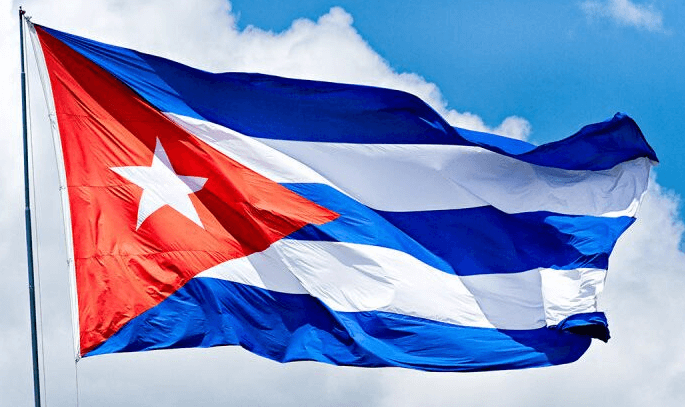The Cuba National Flag is more than just a piece of cloth; it is a powerful symbol of the nation's history, struggles, and aspirations. In this article, we will delve into the rich symbolism, historical evolution, and cultural significance of the Cuba national flag. From its humble origins to its role in modern Cuba, the flag embodies the spirit of the Cuban people and their journey towards independence and identity.
Origins of the Cuba National Flag
The Cuba national flag traces its roots back to the 19th century, a time of fervent nationalism and aspiration for independence. Created during the Cuban War of Independence against Spanish colonial rule, the flag was first hoisted on May 20, 1902, upon the nation's declaration of independence.
Cuba National Flag: Design and Colors
The flag's design features five alternating blue and white horizontal stripes, with a red equilateral triangle on the hoist side, containing a white five-pointed star. Each color holds profound significance: blue represents the clear skies and purity of Cuba's ideals, white symbolizes peace and light, and red signifies the blood shed by those who fought for the nation's freedom.
Cuba National Flag: Revolutionary Symbolism
The Flag as a Revolutionary Emblem
The Cuba national flag became a potent symbol during the Cuban Revolution, led by Fidel Castro and his comrades. It was a rallying point for rebels, representing their struggle against oppression and imperialism. The flag adorned uniforms, banners, and makeshift barricades, inspiring unity and resilience among the revolutionary forces.
Fidel Castro and the Flag
Fidel Castro, the charismatic leader of the revolution, often spoke about the flag's significance in his speeches. He saw it as a beacon of hope, guiding the nation towards a brighter future. Castro's passionate connection with the flag further solidified its role as a unifying emblem of change.
Historical Evolution of Cuba National Flag
Early Colonial Flags
Before the adoption of the current design, Cuba had seen various flags representing different rulers and influences, from Spanish colonial banners to flags of foreign conquerors.
Flag During Spanish Rule
Under Spanish rule, Cuba had its flag, known as the "Lone Star" flag, which symbolized the island's aspirations for autonomy within the Spanish monarchy.
Role in the War of Independence
The Cuba national flag played a pivotal role in the War of Independence. It was carried by rebel armies as they fought valiantly against Spanish forces, serving as a potent reminder of their ultimate goal: a free and sovereign Cuba.
Cultural Significance of Cuba National Flag
Flag in Contemporary Cuba
The flag remains an integral part of Cuba's cultural landscape. It can be seen proudly displayed in public spaces, government buildings, and schools throughout the nation.
National Holidays and Flag Display
During national holidays and important commemorative events, the flag takes center stage. Its presence symbolizes the unity and shared heritage of the Cuban people.
Art and Literature Inspired by the Flag
The flag's vibrant colors and powerful symbolism have inspired artists, writers, and poets for generations. It has become a muse for creative expression, embodying the spirit of Cuba's past and its hopes for the future.
The Flag’s Impact on Society
Unity and Patriotism
The Cuba national flag fosters a sense of unity and patriotism among citizens. It serves as a reminder of the struggles the nation has overcome and the resilience of its people.
Flag in International Relations
The flag represents Cuba on the global stage, signifying the nation's unique identity and its commitment to sovereignty and self-determination.
Educational Significance
In schools across Cuba, students learn about the flag's history and significance. It serves as a tool for educating younger generations about their heritage and the importance of national pride.
Cuba National Flag: Preserving the Legacy
Conservation and Display
Efforts to preserve the Cuba national flag are ongoing. Conservationists work tirelessly to ensure that this iconic symbol remains intact for future generations to admire and appreciate.
Flag Etiquette
Cubans hold the flag in high regard and adhere to specific etiquette when handling and displaying it. This respect underscores the deep cultural and emotional connection between the flag and the Cuban people.
FAQs about the Cuba National Flag
- What do the colors of the Cuba national flag represent?
The blue represents purity and the sky, white symbolizes peace and light, and red stands for the blood shed in the pursuit of independence.
- Who designed the Cuba national flag?
The flag's design is credited to Narciso López, a Venezuelan-Cuban revolutionary.
- Why is the flag often associated with Fidel Castro?
The flag became a powerful symbol of the Cuban Revolution, with Fidel Castro embracing it as a representation of the people's fight against oppression.
- Are there any specific rules for displaying the Cuba national flag?
Yes, there are guidelines for displaying and handling the flag to show proper respect.
- How has the flag influenced Cuban art and literature?
The flag's vibrant colors and symbolism have inspired numerous artists and writers, becoming a recurring motif in their works.
Conclusion
The Cuba national flag is a testament to the indomitable spirit of the Cuban people. It encapsulates a history of struggle, resilience, and the unwavering pursuit of freedom. With its vibrant colors and powerful symbolism, the flag continues to inspire unity, patriotism, and creativity in Cuba and beyond.
References
- "Flag of Cuba." Wikipedia. https://en.wikipedia.org/wiki/Flag_of_Cuba
- "National Symbols of Cuba." Embassy of the Republic of Cuba in the United States. https://misiones.minrex.gob.cu/en/articulo/national-symbols-cuba
- "The Cuba National Flag." Totally Cuba. https://www.totallycuba.com/about-cuba/national-flag.html
- "Flags of the World: Cuba." CRW Flags Inc. https://www.crwflags.com/fotw/flags/cu.html
- "Cuba's National Symbols." Cuba Culture. https://www.cubaculture.org/arts-culture/cubas-national-symbols/
